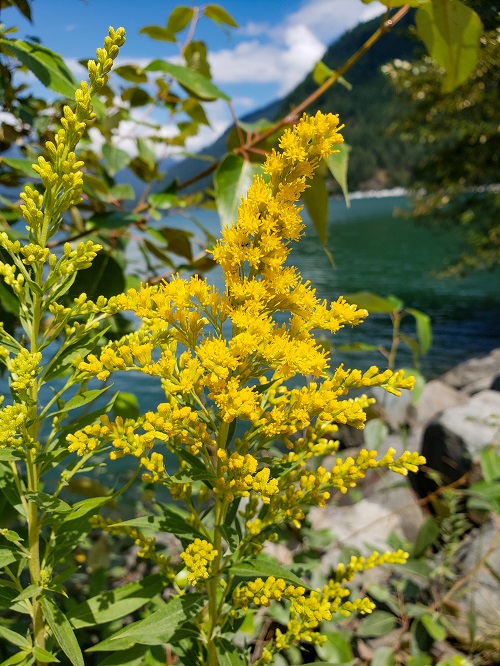Always wondered what Nebraska State Flower is? Well, it’s time to get all the information and details related to the plant!
Discover the vibrant allure of Nebraska state flower—Goldenrod, a symbol of resilience and natural beauty that captivates everyone from garden enthusiasts to environmentalists. As this sun-kissed perennial bursts into brilliant yellow plumes, it not only transforms the landscape into a golden paradise but also invites a myriad of pollinators, enriching biodiversity.
USDA Zones: 4-9
Common Names: Goldenrod, Giant Goldenrod
Check Out Our Article On Texas State Flower Here
Nebraska State Flower Information
Nebraska proudly claims the Goldenrod (Solidago gigantea) as its official state flower. This vibrant and cheerful plant was designated as the state flower in 1895 and is known for vibrant cheer, mirroring the resilient spirit of the state.
With a natural affinity for meadows and roadsides, the Goldenrod thrives within these landscapes, seamlessly blending into the state’s picturesque scenery. Nebraska’s varied conditions, provide a welcoming habitat for the Goldenrod.
Appearance: Nebraska state flower boasts an elegant presence, standing tall with a height ranging from 3 to 5 feet. Its elongated stems are adorned with clusters of small, daisy-like flowers, creating a mesmerizing display. The lance-shaped leaves are sharply toothed, adding to the plant’s unique texture.
Blooming Season: The Goldenrod graces Nebraska with its vibrant blossoms from late summer through fall. Its blooming season typically spans from August to October, painting the landscape with brilliant bursts of yellow. This timing coincides with the changing seasons, making it a symbol of transition and embracing the beauty of nature’s cycles.
Significance: The Nebraska state flower holds significant value for Nebraska, symbolizing the state’s rich flora and inherent resilience. Its bright hue reflects the optimism and determination of Nebraskans, especially in the face of challenges. Moreover, the Goldenrod provides essential nectar for pollinators, contributing to the vitality of local ecosystems.
Conservation: Efforts to conserve the Goldenrod by preserving the prairies, meadows, and open spaces where the Goldenrod thrives ensure the survival of this iconic flower. Conservation initiatives include habitat restoration, promoting pollinator-friendly practices, and raising awareness about the importance of native plants.
Delaware State Flower and Growing Guide
Nebraska State Flower – Quick Growing Tips
- Opt for well-drained, loamy to sandy soil. A slightly acidic to neutral pH range (6.0-7.0) is ideal.
- Nebraska State Flower Prefers full sun but can tolerate partial shade.
- Water moderately; the plant is drought-tolerant once mature.
- A balanced fertilizer can be applied in the early spring, but Goldenrod often does well without additional nutrients.
- Space plants about 18 to 24 inches apart to allow for growth and airflow.
- Deadheading spent blooms encourages more flowering.
- Generally resistant to most pests and diseases. Keep an eye out for powdery mildew and treat as needed.
- Cut back the dead foliage in late fall or early spring to encourage new growth.
Connecticut State Flower and How to Grow It
Nebraska State Flower – FAQs
1. What does Goldenrod look like?
Nebraska state flower features tall, slender stems with bright yellow, fluffy flower heads that form a plume-like appearance. The leaves are lanceolate and usually have rough edges.
2. Where One Can Find Goldenrod in Nebraska?
Goldenrod is a native plant that’s common in prairies, meadows, and along roadsides across Nebraska.
3. How does Goldenrod adapt to Nebraska’s climate?
Goldenrod grows well in Nebraska’s varying climate, as it’s drought-tolerant and can thrive in full sun to partial shade.
4. Is Goldenrod an allergen?
Contrary to popular belief, Goldenrod is not a significant allergen. Its pollen is heavy and doesn’t sway in the wind, unlike ragweed, which blooms around the same time and is a common allergen.
5. Can You Use Goldenrod for medicinal purposes?
Yes, Goldenrod has traditional uses as a herbal remedy for conditions like urinary tract infections, inflammation, and respiratory issues.
Find Out All About New Hampshire State Flower And How To Grow It Here
6. Is Goldenrod invasive?
In its native range, including Nebraska, Goldenrod is not considered invasive. However, it can become invasive in certain conditions or in non-native areas.
7. How can I grow Goldenrod in my garden?
Goldenrod prefers well-drained, loamy to sandy soil and full sun. It’s drought-tolerant once established and generally requires minimal care.
8. What wildlife does Goldenrod attract?
Goldenrod is known for attracting a variety of pollinators, including bees and butterflies. It also provides habitat for beneficial insects.
9. Can Goldenrod be used in floral arrangements?
Yes, the bright yellow flowers of Nebraska state flower make it a popular choice for late summer and fall floral arrangements.
10. What other plants pair well with Goldenrod in a garden?
Goldenrod pairs well with other native perennials like coneflower, aster, and switchgrass for a diverse, pollinator-friendly garden.



